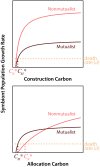Carbon allocation and competition maintain variation in plant root mutualisms
- PMID: 29938093
- PMCID: PMC6010867
- DOI: 10.1002/ece3.4118
Carbon allocation and competition maintain variation in plant root mutualisms
Abstract
Plants engage in multiple root symbioses that offer varying degrees of benefit. We asked how variation in partner quality persists using a resource-ratio model of population growth. We considered the plant's ability to preferentially allocate carbon to mutualists and competition for plant carbon between mutualist and nonmutualist symbionts. We treated carbon as two nutritionally interchangeable, but temporally separated, resources-carbon allocated indiscriminately for the construction of the symbiosis, and carbon preferentially allocated to the mutualist after symbiosis establishment and assessment. This approach demonstrated that coexistence of mutualists and nonmutualists is possible when fidelity of the plant to the mutualist and the cost of mutualism mediate resource competition. Furthermore, it allowed us to trace symbiont population dynamics given varying degrees of carbon allocation. Specifically, coexistence occurs at intermediate levels of preferential allocation. Our findings are consistent with previous empirical studies as well the application of biological market theory to plantroot symbioses.
Keywords: biological market theory; cheating; preferential allocation; resource competition; species coexistence.
Figures


Similar articles
-
Preferential Allocation of Benefits and Resource Competition among Recipients Allows Coexistence of Symbionts within Hosts.Am Nat. 2022 Apr;199(4):468-479. doi: 10.1086/718643. Epub 2022 Feb 21. Am Nat. 2022. PMID: 35324376
-
Preferential allocation, physio-evolutionary feedbacks, and the stability and environmental patterns of mutualism between plants and their root symbionts.New Phytol. 2015 Mar;205(4):1503-1514. doi: 10.1111/nph.13239. Epub 2015 Jan 5. New Phytol. 2015. PMID: 25561086
-
Host discrimination in modular mutualisms: a theoretical framework for meta-populations of mutualists and exploiters.Proc Biol Sci. 2016 Jan 13;283(1822):20152428. doi: 10.1098/rspb.2015.2428. Proc Biol Sci. 2016. PMID: 26740613 Free PMC article.
-
Integrating plant carbon dynamics with mutualism ecology.New Phytol. 2016 Apr;210(1):71-5. doi: 10.1111/nph.13679. Epub 2015 Sep 28. New Phytol. 2016. PMID: 26414800 Review.
-
Competition and coexistence: exploring mechanisms that restrict and maintain diversity within mutualist guilds.Am Nat. 2003 Oct;162(4 Suppl):S63-79. doi: 10.1086/378682. Am Nat. 2003. PMID: 14583858 Review.
Cited by
-
Plant-mediated partner discrimination in ectomycorrhizal mutualisms.Mycorrhiza. 2019 Mar;29(2):97-111. doi: 10.1007/s00572-018-00879-7. Epub 2019 Jan 7. Mycorrhiza. 2019. PMID: 30617861
-
Ectomycorrhizal access to organic nitrogen mediates CO2 fertilization response in a dominant temperate tree.Nat Commun. 2021 Sep 13;12(1):5403. doi: 10.1038/s41467-021-25652-x. Nat Commun. 2021. PMID: 34518539 Free PMC article.
-
Mutualism at the leading edge: insights into the eco-evolutionary dynamics of host-symbiont communities during range expansion.J Math Biol. 2024 Feb 2;88(2):24. doi: 10.1007/s00285-023-02037-w. J Math Biol. 2024. PMID: 38308102
-
Arbuscular mycorrhizal fungal spore communities and co-occurrence networks demonstrate host-specific variation throughout the growing season.Mycorrhiza. 2024 Nov;34(5-6):463-475. doi: 10.1007/s00572-024-01168-2. Epub 2024 Sep 18. Mycorrhiza. 2024. PMID: 39292437 Free PMC article.
References
-
- Batstone, R. T. , Dutton, E. M. , Wang, D. , Yang, M. , & Frederickson, M. E. (2017). The evolution of symbiont preference traits in the model legume Medicago truncatula . New Phytologist, 213, 1850–1861. https://doi.org/10.1111/nph.14308 - DOI - PubMed
-
- Bennett, A. E. , & Bever, J. D. (2009). Trade‐offs between arbuscular mycorrhizal fungal competitive ability and host growth promotion in Plantago lanceolata . Oecologia, 160, 807–816. https://doi.org/10.1007/s00442-009-1345-6 - DOI - PubMed
-
- Bever, J. D. (2015). Preferential allocation, physio‐evolutionary feedbacks, and the stability and environmental patterns of mutualism between plants and their root symbionts. New Phytologist, 205, 1503–1514. https://doi.org/10.1111/nph.13239 - DOI - PubMed
-
- Bever, J. D. , Richardson, S. C. , Lawrence, B. M. , Holmes, J. , & Watson, M. (2009). Preferential allocation to beneficial symbiont with spatial structure maintains mycorrhizal mutualism. Ecology Letters, 12, 13–21. https://doi.org/10.1111/j.1461-0248.2008.01254.x - DOI - PubMed
-
- Bever, J. D. , Schultz, P. A. , Pringle, A. , & Morton, J. B. (2001). Arbuscular mycorrhizal fungi: More diverse than meets the eye, and the ecological tale of why. BioScience, 51, 923–932. https://doi.org/10.1641/0006-3568(2001)051[0923:AMFMDT]2.0.CO;2 - DOI
LinkOut - more resources
Full Text Sources
Other Literature Sources

